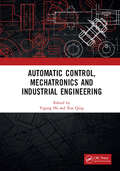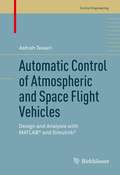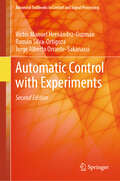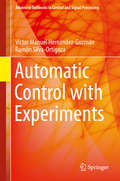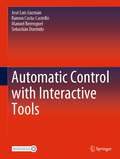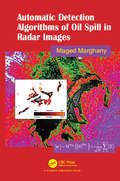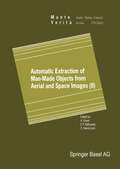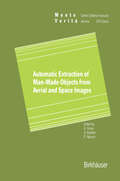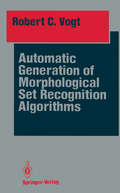- Table View
- List View
Automatic Analog IC Sizing and Optimization Constrained with PVT Corners and Layout Effects
by Nuno Lourenço Ricardo Martins Nuno HortaThis book introduces readers to a variety of tools for automatic analog integrated circuit (IC) sizing and optimization. The authors provide a historical perspective on the early methods proposed to tackle automatic analog circuit sizing, with emphasis on the methodologies to size and optimize the circuit, and on the methodologies to estimate the circuit’s performance. The discussion also includes robust circuit design and optimization and the most recent advances in layout-aware analog sizing approaches. The authors describe a methodology for an automatic flow for analog IC design, including details of the inputs and interfaces, multi-objective optimization techniques, and the enhancements made in the base implementation by using machine leaning techniques. The Gradient model is discussed in detail, along with the methods to include layout effects in the circuit sizing. The concepts and algorithms of all the modules are thoroughly described, enabling readers to reproduce the methodologies, improve the quality of their designs, or use them as starting point for a new tool. An extensive set of application examples is included to demonstrate the capabilities and features of the methodologies described.
Automatic Autocorrelation and Spectral Analysis
by Petrus M.T. BroersenSpectral analysis requires subjective decisions which influence the final estimate and mean that different analysts can obtain different results from the same stationary stochastic observations. Statistical signal processing can overcome this difficulty, producing a unique solution for any set of observations but that is only acceptable if it is close to the best attainable accuracy for most types of stationary data. This book describes a method which fulfils the above near-optimal-solution criterion, taking advantage of greater computing power and robust algorithms to produce enough candidate models to be sure of providing a suitable candidate for given data.
Automatic Calibration and Reconstruction for Active Vision Systems (Intelligent Systems, Control and Automation: Science and Engineering #57)
by Beiwei Zhang Y. F. LiIn this book, the design of two new planar patterns for camera calibration of intrinsic parameters is addressed and a line-based method for distortion correction is suggested. The dynamic calibration of structured light systems, which consist of a camera and a projector is also treated. Also, the 3D Euclidean reconstruction by using the image-to-world transformation is investigated. Lastly, linear calibration algorithms for the catadioptric camera are considered, and the homographic matrix and fundamental matrix are extensively studied. In these methods, analytic solutions are provided for the computational efficiency and redundancy in the data can be easily incorporated to improve reliability of the estimations. This volume will therefore prove valuable and practical tool for researchers and practioners working in image processing and computer vision and related subjects.
Automatic Control and Emerging Technologies: Proceedings of ACET 2023 (Lecture Notes in Electrical Engineering #1141)
by Hassan El Fadil Weicun ZhangThis book contains the original, peer-reviewed research papers from the International Symposium on Automatic Control and Emerging Technologies, held in Kenitra, Morrocco, on July 11-13, 2023. The topics covered include but are not limited to: System Identification, Linear/Nonlinear Control Systems, Data-driven Modelling and Control, Process Modelling and Process Control, Fault Diagnosis and Reliable Control, Intelligent Systems, and Machine Learning and Artificial Intelligence.The papers showcased here share the latest findings on topics with potential for academic research and industrial applications, making the book a valuable resource for researchers, engineers, and university students alike.
Automatic Control, Mechatronics and Industrial Engineering: Proceedings of the International Conference on Automatic Control, Mechatronics and Industrial Engineering (ACMIE 2018), October 29-31, 2018, Suzhou, China
Engineering technology development and implementation play an important role in making the industry more sustainable in an increasingly competitive world. This book covers significant recent developments in both fundamental and applied research in the engineering field. Domains of application include, but are not limited to, Intelligent Control Systems and Optimization, Signal Processing, Sensors, Systems Modeling and Control, Robotics and Automation, Industrial and Electric Engineering, Production and Management. This book is an excellent reference work to get up to date with the latest research and developments in the fields of Automation, Mechatronics and Industrial Engineering. It aims to provide a platform for researchers and professionals in all relevant fields to gain new ideas and establish great achievements in scientific development.
Automatic Control of Atmospheric and Space Flight Vehicles: Design and Analysis with MATLAB® and Simulink® (Control Engineering)
by Ashish TewariAutomatic Control of Atmospheric and Space Flight Vehicles is perhaps the first book on the market to present a unified and straightforward study of the design and analysis of automatic control systems for both atmospheric and space flight vehicles. Covering basic control theory and design concepts, it is meant as a textbook for senior undergraduate and graduate students in modern courses on flight control systems. In addition to the basics of flight control, this book covers a number of upper-level topics and will therefore be of interest not only to advanced students, but also to researchers and practitioners in aeronautical engineering, applied mathematics, and systems/control theory.
Automatic Control of Food Manufacturing Processes
by I. McFarlaneIn the ten years since the first edition of this book appeared there have been significant developments in food process engineering, notably in biotechnology and membrane application. Advances have been made in the use of sensors for process control, and the growth of information technology and on-line computer applications continues apace. In addition, plant investment decisions are increasingly determined by quality assurance considerations and have to incorporate a greater emphasis on health and safety issues. The content of this edition has been rearranged to include descriptions of recent developments and to reflect the influence of new technology on the control and operations of automated plant. Original examples have been retained where relevant and these, together with many new illustrations, provide a comprehensive guide to good practice.
Automatic Control, Robotics, and Information Processing (Studies in Systems, Decision and Control #296)
by Piotr Kulczycki Józef Korbicz Janusz KacprzykThis book presents a wide and comprehensive range of issues and problems in various fields of science and engineering, from both theoretical and applied perspectives. The desire to develop more effective and efficient tools and techniques for dealing with complex processes and systems has been a natural inspiration for the emergence of numerous fields of science and technology, in particular control and automation and, more recently, robotics. The contributions gathered here concern the development of methods and algorithms to determine best practices regarding broadly perceived decisions or controls. From an engineering standpoint, many of them focus on how to automate a specific process or complex system. From a tools-based perspective, several contributions address the development of analytic and algorithmic methods and techniques, devices and systems that make it possible to develop and subsequently implement the automation and robotization of crucial areas of human activity. All topics discussed are illustrated with sample applications.
Automatic Control Systems: With MATLAB
by S. PalaniThis book is designed to serve as a textbook for courses offered to undergraduate students enrolled in Electrical Engineering and related disciplines. The book provides a comprehensive coverage of linear system theory. In this book, the concepts around each topic are well discussed with a full-length presentation of numerical examples. Each example is unique in its way, and it is graded sequentially. This book highlights simple methods for solving problems. Even though, the subject requires a very strong mathematical foundation, wherever possible, rigorous mathematics is simplified for a quick understanding of the basic concepts. The book also includes select numerical problems to test the capability of the students. Time and frequency domain approaches for the analysis and design of linear automatic control systems have been explained using state-space and transfer function models of physical systems. All the chapters include a short theoretical summary of the topic followed by exercises on solving complex problems using MATLAB commands. In addition, each chapter offers a large number of end-of-chapter homework problems. This second edition includes a new chapter on state-space modeling and analysis. Detailed conceptual coverage and pedagogical tools make this an ideal textbook for students and researchers enrolled in electrical engineering and related programs.
Automatic Control Systems in Biomedical Engineering: An Interactive Educational Approach
by J. Fernández de Cañete C. Galindo J. Barbancho A. LuqueThis book presents the fundamental principles and challenges encountered in the control of biomedical systems, providing practical solutions and suggesting alternatives. The perspective of the text is based on the system behaviour in the time domain both linear and non-linear, continuous and discrete, helping the reader to be able to interpret the physical significance of mathematical results during control system analysis and design focusing on biomedical engineering applications. Interactive learning is promoted, endowing students with the ability to change parameters and conditions during the simulation and see the effects of these changes, by using interactive MATLAB and SIMULINK software tools, also presenting realistic problems in order to analyse, design and develop automatic control systems. The text is also complemented with MATLAB and SIMULINK exercise files solved to aid students to focus on the fundamental concepts treated throughout the book, following a new pedagogical approach distinct from the classical one whereby fundamental control concepts are introduced together with adequate software tools in order to gain insight on the biomedical engineering control problems. The book is suitable for second or third-year undergraduate students who will find the illustrative examples particularly useful to their studies of control system design and implementation. Lecturers in the control field will find the computer aided design approach as an alternative to teaching the fundamental concepts of feedback analogic and digital control.
Automatic Control with Experiments (Advanced Textbooks in Control and Signal Processing)
by Victor Manuel Hernández-Guzmán Ramón Silva-Ortigoza Jorge Alberto Orrante-SakanassiThis book offers an enhanced and comprehensive understanding of control theory and its practical applications. The theoretical chapters on control tools have been meticulously revised and improved to provide a clearer and more insightful exploration of the fundamental concepts and ideas. The explanations have been refined, and new examples have been added to aid comprehension. Additionally, a new chapter on discrete-time systems has been included, delving into an important aspect of control theory. Advanced topics in control are also covered in greater detail, ensuring a comprehensive treatment of the subject matter. The section on experimental applications has been revamped to showcase the application of control ideas in various scenarios. Several chapters have been replaced with fresh content that focuses on controlling new and different experimental prototypes. These examples illustrate how control concepts can be effectively applied in real-world situations. Furthermore,this book introduces a new approach for control of non-minimum phase systems and explores the concept of differential flatness for multiple-input multiple-output systems. Additionally, a fascinating application involving a wheeled pendulum mobile robot has been included. While some chapters have been replaced, the second edition retains the chapters on the control of DC motors and the control of a magnetic levitation system. However, the material in the former chapter is mostly new, and the latter chapter is entirely supported by new control concepts and ideas.
Automatic Control with Experiments (Advanced Textbooks in Control and Signal Processing)
by Victor Manuel Hernández-Guzmán Ramón Silva-OrtigozaThis textbook presents theory and practice in the context of automatic control education. It presents the relevant theory in the first eight chapters,applying them later on to the control of several real plants. Each plant is studied following a uniform procedure: a) the plant’s functionis described, b) a mathematical model is obtained, c) plant construction is explained in such a way that the reader can build his or her own plant to conduct experiments, d) experiments are conducted to determine the plant’s parameters, e) a controller is designed using the theory discussed in the first eight chapters, f) practical controller implementation is performed in such a way that the reader can build the controller in practice, and g) the experimental results are presented. Moreover, the book provides a wealth of exercises and appendices reviewing the foundations of several concepts and techniques in automatic control. The control system construction proposed is based on inexpensive, easy-to-use hardware. An explicit procedure for obtaining formulas for the oscillation condition and the oscillation frequency of electronic oscillator circuits is demonstrated as well.
Automatic Control with Interactive Tools
by José Luis Guzmán Ramon Costa-Castelló Manuel Berenguel Sebastián DormidoAutomatic Control with Interactive Tools is a textbook for undergraduate study of automatic control. Providing a clear course structure, and covering concepts taught in engineering degrees, this book is an ideal companion to those studying or teaching automatic control. The authors have used this text successfully to teach their students.By providing unique interactive tools, which have been designed to illustrate the most important automatic control concepts, Automatic Control with Interactive Tools helps students overcome the potential barriers presented by the significant mathematical content of automatic control courses. Even when they have previously had only the benefit of an introductory control course, the software tools presented will help readers to get to grips with the use of such techniques as differential equations, linear algebra, and differential geometry. This textbook covers the breadth of automatic control topics, including time responses of dynamic systems, the Nyquist criterion and PID control. It switches smoothly between analytical and practical approaches. Automatic Control with Interactive Tools offers a clear introduction to automatic control, ideal for undergraduate students, instructors and anyone wishing to familiarize themselves with the fundamentals of the subject
Automatic Detection Algorithms of Oil Spill in Radar Images
by Maged MarghanySynthetic Aperture Radar Automatic Detection Algorithms (SARADA) for Oil Spills conveys the pivotal tool required to fully comprehend the advanced algorithms in radar monitoring and detection of oil spills, particularly quantum computing and algorithms as a keystone to comprehending theories and algorithms behind radar imaging and detection of marine pollution. Bridging the gap between modern quantum mechanics and computing detection algorithms of oil spills, this book contains precise theories and techniques for automatic identification of oil spills from SAR measurements. Based on modern quantum physics, the book also includes the novel theory on radar imaging mechanism of oil spills. With the use of precise quantum simulation of trajectory movements of oil spills using a sequence of radar images, this book demonstrates the use of SARADA for contamination by oil spills as a promising novel technique. Key Features: Introduces basic concepts of a radar remote sensing. Fills a gap in the knowledge base of quantum theory and microwave remote sensing. Discusses the important aspects of oil spill imaging in radar data in relation to the quantum theory. Provides recent developments and progresses of automatic detection algorithms of oil spill from radar data. Presents 2-D oil spill radar data in 4-D images.
Automatic Detection Algorithms of Oil Spill in Radar Images
by Maged MarghanySynthetic Aperture Radar Automatic Detection Algorithms (SARADA) for Oil Spills conveys the pivotal tool required to fully comprehend the advanced algorithms in radar monitoring and detection of oil spills, particularly quantum computing and algorithms as a keystone to comprehending theories and algorithms behind radar imaging and detection of marine pollution. Bridging the gap between modern quantum mechanics and computing detection algorithms of oil spills, this book contains precise theories and techniques for automatic identification of oil spills from SAR measurements. Based on modern quantum physics, the book also includes the novel theory on radar imaging mechanism of oil spills. With the use of precise quantum simulation of trajectory movements of oil spills using a sequence of radar images, this book demonstrates the use of SARADA for contamination by oil spills as a promising novel technique. Key Features: Introduces basic concepts of a radar remote sensing. Fills a gap in the knowledge base of quantum theory and microwave remote sensing. Discusses the important aspects of oil spill imaging in radar data in relation to the quantum theory. Provides recent developments and progresses of automatic detection algorithms of oil spill from radar data. Presents 2-D oil spill radar data in 4-D images.
Automatic Detection of Irony: Opinion Mining in Microblogs and Social Media
by Jihen Karoui Farah Benamara Veronique MoriceauIn recent years, there has been a proliferation of opinion-heavy texts on the Web: opinions of Internet users, comments on social networks, etc. Automating the synthesis of opinions has become crucial to gaining an overview on a given topic. Current automatic systems perform well on classifying the subjective or objective character of a document. However, classifications obtained from polarity analysis remain inconclusive, due to the algorithms' inability to understand the subtleties of human language. Automatic Detection of Irony presents, in three stages, a supervised learning approach to predicting whether a tweet is ironic or not. The book begins by analyzing some everyday examples of irony and presenting a reference corpus. It then develops an automatic irony detection model for French tweets that exploits semantic traits and extralinguistic context. Finally, it presents a study of portability in a multilingual framework (Italian, English, Arabic).
Automatic Detection of Irony: Opinion Mining in Microblogs and Social Media
by Jihen Karoui Farah Benamara Veronique MoriceauIn recent years, there has been a proliferation of opinion-heavy texts on the Web: opinions of Internet users, comments on social networks, etc. Automating the synthesis of opinions has become crucial to gaining an overview on a given topic. Current automatic systems perform well on classifying the subjective or objective character of a document. However, classifications obtained from polarity analysis remain inconclusive, due to the algorithms' inability to understand the subtleties of human language. Automatic Detection of Irony presents, in three stages, a supervised learning approach to predicting whether a tweet is ironic or not. The book begins by analyzing some everyday examples of irony and presenting a reference corpus. It then develops an automatic irony detection model for French tweets that exploits semantic traits and extralinguistic context. Finally, it presents a study of portability in a multilingual framework (Italian, English, Arabic).
Automatic Differentiation: (pdf) (Lecture Notes in Computational Science and Engineering #50)
by H. Martin Bücker George Corliss Paul Hovland Uwe Naumann Boyana NorrisAutomatic Extraction of Man-Made Objects from Aerial and Space Images (Monte Verita)
by Armin Gruen E. P. Baltsavias O. HenricssonAdvancements in digital sensor technology, digital image analysis techniques, as well as computer software and hardware have brought together the fields of computer vision and photogrammetry, which are now converging towards sharing, to a great extent, objectives and algorithms. The potential for mutual benefits by the close collaboration and interaction of these two disciplines is great, as photogrammetric know-how can be aided by the most recent image analysis developments in computer vision, while modern quantitative photogrammetric approaches can support computer vision activities. Devising methodologies for automating the extraction of man-made objects (e.g. buildings, roads) from digital aerial or satellite imagery is an application where this cooperation and mutual support is already reaping benefits. The valuable spatial information collected using these interdisciplinary techniques is of improved qualitative and quantitative accuracy. This book offers a comprehensive selection of high-quality and in-depth contributions from world-wide leading research institutions, treating theoretical as well as implementational issues, and representing the state-of-the-art on this subject among the photogrammetric and computer vision communities.
Automatic Extraction of Man-Made Objects from Aerial Space Images (Monte Verita)
by Armin Gruen Olaf Kuebler Peggy AgourisAdvancements in digital sensor technology, digital image analysis techniques, as well as computer software and hardware have brought together the fields of computer vision and photogrammetry, which are now converging towards sharing, to a great extent, objectives and algorithms. The potential for mutual benefits by the close collaboration and interaction of these two disciplines is great, as photogrammetric know-how can be aided by the most recent image analysis developments in computer vision, while modern quantitative photogrammetric approaches can support computer vision activities. Devising methodologies for automating the extraction of man-made objects (e.g. buildings, roads) from digital aerial or satellite imagery is an application where this cooperation and mutual support is already reaping benefits. The valuable spatial information collected using these interdisciplinary techniques is of improved qualitative and quantitative accuracy. This book offers a comprehensive selection of high-quality and in-depth contributions from world-wide leading research institutions, treating theoretical as well as implementational issues, and representing the state-of-the-art on this subject among the photogrammetric and computer vision communities.
Automatic Flight Control Systems (Synthesis Lectures on Mechanical Engineering)
by Mohammad SadraeyThis book provides readers with a design approach to the automatic flight control systems (AFCS). The AFCS is the primary on-board tool for long flight operations, and is the foundation for the airspace modernization initiatives. In this text, AFCS and autopilot are employed interchangeably. It presents fundamentals of AFCS/autopilot, including primary subsystems, dynamic modeling, AFCS categories/functions/modes, servos/actuators, measurement devices, requirements, functional block diagrams, design techniques, and control laws. The book consists of six chapters. The first two chapters cover the fundamentals of AFCS and closed-loop control systems in manned and unmanned aircraft. The last four chapters present features of Attitude control systems (Hold functions), Flight path control systems (Navigation functions), Stability augmentation systems, and Command augmentation systems, respectively.
Automatic Gain Control: Techniques and Architectures for RF Receivers (Analog Circuits and Signal Processing)
by Juan Pablo Alegre Pérez Santiago Celma Pueyo Belén Calvo LópezThis book analyzes automatic gain control (AGC) loop circuits and demonstrates AGC solutions in the environment of wireless receivers, mainly in wireless receivers with stringent constraints in settling-time and wide dynamic range, such as WLAN and Bluetooth receivers. Since feedforward AGCs present great advantages in this context, as an alternative to conventional feedback AGCs, this book includes a detailed study of feedforward AGCs design –at the level of basic AGC cells, as well as the system level, including their main characteristics and performance.
Automatic Generation of Morphological Set Recognition Algorithms (Springer Series in Perception Engineering)
by Robert C. VogtSince the early days of computers, machine learning and automatic programming have attracted researchers in computer science and related fields, particularly pattern recognition and automatic control theory. Most of the learning concepts in machine perception have been inspired by pattern recognition approaches that rely on statistical techniques. These statistical techniques have applicability in limited recognition tasks. Automatic programming in perception systems has generally been limited to interfaces that allow easy specification of the task using natural language. Clearly, machine learning and automatic programming can make percep tion systems powerful and easy to use. Vogt's book addresses both these tasks in the context of machine vision. He uses morphological operations to implement his approach which was developed for solving the figure-ground problem in images. His system selects the correct se quence of operators to accept or reject pixels for fmding objects in an image. The sequence of operators is selected after a user specifies what the correct objects are. On the surface it may appear that the problem solved by the system is not very interesting, however, the contribution ofVogt' s work should not be judged by the images that the system can segment. Its real contribution is in demonstrat ing, possibly for'the frrst time, that automatic programming is possible in computer vision systems. The selection of morphological operators demonstrates that to implement an automatic programming-based approach, operators whose behavior is clearly defined in the image space are required.
Automatic Layout Modification: Including design reuse of the Alpha CPU in 0.13 micron SOI technology
by Michael ReinhardtThis volume is a welcome effort towards improving some of the practices in chip design today. The authors provide a comprehensive reference work on Automatic Layout Modification which will be valuable to VLSI courses at universities, and to CAD and circuit engineers and engineering managers.
Automatic Learning Techniques in Power Systems (Power Electronics and Power Systems)
by Louis A. WehenkelAutomatic learning is a complex, multidisciplinary field of research and development, involving theoretical and applied methods from statistics, computer science, artificial intelligence, biology and psychology. Its applications to engineering problems, such as those encountered in electrical power systems, are therefore challenging, while extremely promising. More and more data have become available, collected from the field by systematic archiving, or generated through computer-based simulation. To handle this explosion of data, automatic learning can be used to provide systematic approaches, without which the increasing data amounts and computer power would be of little use. Automatic Learning Techniques in Power Systems is dedicated to the practical application of automatic learning to power systems. Power systems to which automatic learning can be applied are screened and the complementary aspects of automatic learning, with respect to analytical methods and numerical simulation, are investigated. This book presents a representative subset of automatic learning methods - basic and more sophisticated ones - available from statistics (both classical and modern), and from artificial intelligence (both hard and soft computing). The text also discusses appropriate methodologies for combining these methods to make the best use of available data in the context of real-life problems. Automatic Learning Techniques in Power Systems is a useful reference source for professionals and researchers developing automatic learning systems in the electrical power field.




